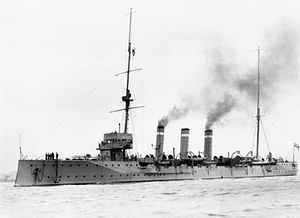 HMS Topaze in wartime service
| |
| History | |
|---|---|
| Name | HMS Topaze |
| Namesake | Topaz |
| Builder | Laird Brothers, Birkenhead |
| Laid down | 14 August 1902 |
| Launched | 23 July 1903 |
| Commissioned | 6 December 1904 |
| Decommissioned | 7 October 1919 |
| Out of service | 22 September 1921 |
| Fate | Sold to be broken up |
| General characteristics | |
| Class and type | Topaze-class protected cruiser |
| Displacement | 3,000 long tons (3,048 t) (deep load) |
| Length | 373 ft 9 in (113.9 m) (o.a.) |
| Beam | 40 ft (12 m) |
| Draught | 14 ft 6 in (4.42 m) |
| Installed power |
|
| Propulsion | 2 4-cylinder triple expansion engines |
| Speed | 21.75 knots (40.3 km/h; 25.0 mph) |
| Range | 7,000 nmi (13,000 km; 8,100 mi) at 10 knots (19 km/h; 12 mph) |
| Complement | 296 |
| Armament |
|
| Armour |
|
HMS Topaze was a Topaze-class protected or third-class cruiser which served in the Royal Navy during the First World War. The vessel was the lead ship of the class, also known as the Gem class, which had a more powerful armament and were faster than preceding protected cruisers. Launched on 23 June 1904, Topaze joined the Channel Fleet and often acted as a flotilla leader for the destroyers of the Navy. At the beginning of the First World War, the cruiser operated with the Fifth Battle Squadron, but was transferred to the Mediterranean Fleet in 1915. There, the cruiser operated with ships of the Italian Regia Marina to enforce the blockade on Albania and to escort ships carrying Italian troops and supplies across the Adriatic Sea. Topaze escorted shipping in the Indian Ocean and captured the Ottoman Army garrison on the island of Kamaran in 1917, but returned to the Mediterranean before the end of the year. After the Armistice in 1918, the cruiser returned to the United Kingdom and was decommissioned on 7 October 1919.